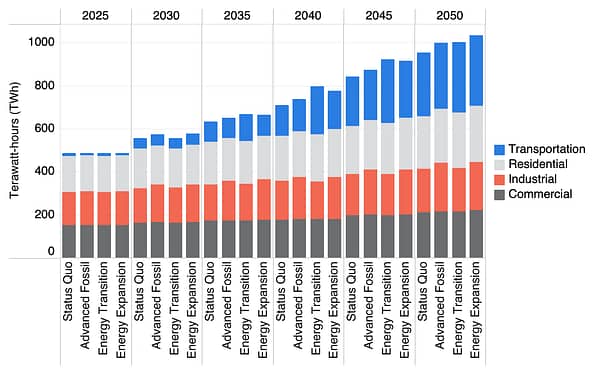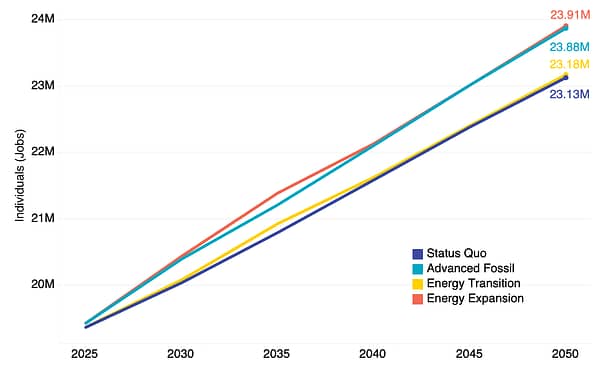A first look at our new Future of Texas Energy dashboard
This is a preview of our Texas 2036 newsletter with a first look at our new Future of Texas Energy dashboard. To receive this weekly look at our work, sign up here.
Texas will need a lot more energy.
We project a near doubling of electric demand in Texas by the year 2050 — a direct result of the state’s booming economy and population.
A tool to help plan Texas’ energy future
Texas 2036 released this week an innovative online tool that maps across a set of four scenarios how different pathways shape the energy production capacity as well as the economic and environmental outlooks across Texas from now until 2050.
This tool is designed to help address, for example, the challenge of ensuring a ready supply of affordable electricity for the Texas of 2050.
Get a glimpse of our key energy findings.
Here’s a rundown of some other key insights made possible by the Future of Texas Energy Dashboard.
Economy & Jobs
- Increased energy generation, through both greater oil and gas production and renewable energy, contributes to net increases in Texas’ energy output of between 26% and 59% by 2050.
- That, in turn, feeds growth in annual GDP as high as 11%, depending on the region of the state and choices made in energy technologies.
- Total jobs are projected to increase statewide from 19 million in 2025 to between 23 million to 24 million in 2050, a net increase of at least 4 million.
Electricity
- Wholesale electricity prices drop from the $35-40/MWh range in 2025 to below $30/MWh across all modeled scenarios in 2050.
- A double-edged sword? While low electricity prices might be good from a consumer’s perspective, they could make it more difficult to attract future capital investment in dispatchable forms of generation, particularly natural gas-fueled electricity generation.
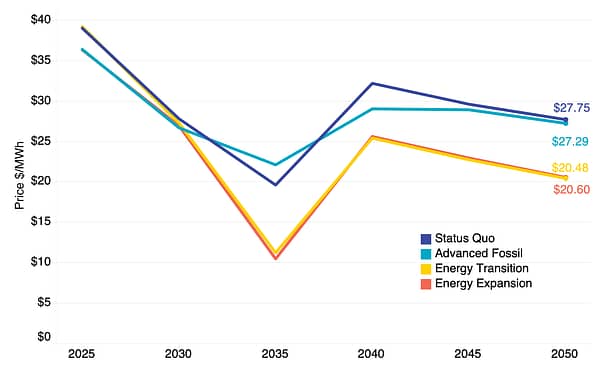
🗓️ What’s going on with prices in 2035? Our model captures activity to get renewable electric projects online ahead of the 2035 expiration of the federal Production Tax Credit. The price rebounds afterward from the effect of the tax credit’s expiration and as investment in natural gas increases to meet reserve margins. Higher renewable generation means that prices settle at a lower level over the long-term.
- Residential demand to cool residential spaces could increase by as much as 74% by 2050.
- This aligns with prior findings from Texas 2036 that shows the state getting hotter while adding five million more residents between now and 2036.
Emissions
- Greenhouse gas emissions increase in our models by as much as 23.3% or decline by as much as 9.9%.
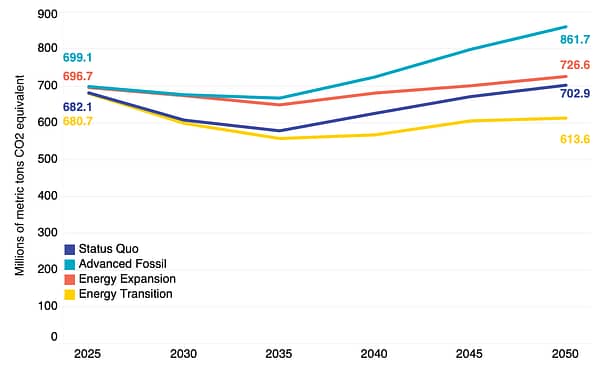
- The “emissions intensity” of Texas’ energy production, or the amount of carbon emissions per energy output, declines across all modeled scenarios.
- The scenario that envisions the biggest gains in energy production also returns the greatest decline.
Transportation
- The number of light-duty vehicles on Texas roadways will increase by as many as eight million by 2050.
- The fuel used by those vehicles will decline by about 40%.
- For heavy-duty vehicles, hydrogen acts as a bridge fuel before the eventual electrification of the fleet.
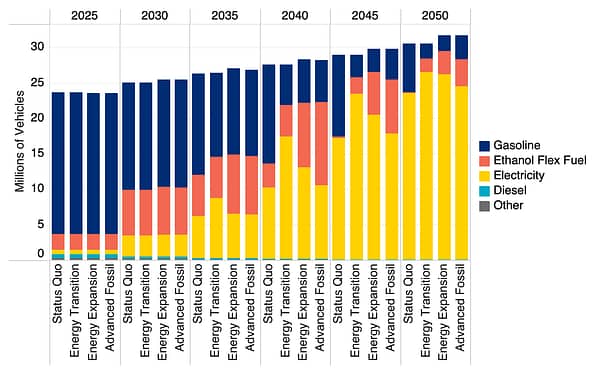
- The transportation sector overall is expected to produce as much as 50% less carbon emissions between now and 2050, due largely to electrification of light-duty and heavy-duty vehicles in the state.
How’d we build it? Let’s dive in on our online tool.

The Future of Texas Energy Dashboard uses a unique modeling framework that tracks the relationship between the state’s energy system and the state’s economy. Each modeled scenario reflects how energy output contributes to economic activity, contributing to a market data-driven approximation of real-world conditions.
The dashboard models four standalone scenarios, each driven by a unique combination of energy technologies that are making headlines today:
- Status Quo: A “business as usual” energy future without major advances in renewable, hydrogen or fossil fuel energy technology.
- Advanced Fossil: An energy future focused on fossil fuel production with carbon capture, utilization and storage.
- Energy Transition: An energy future focused on renewable energy, decarbonization and electrification.
- Energy Expansion: An energy future reflective of an “all-of-the-above” energy policy, where the costs and technologies associated with fossil fuel and renewable production improve over time.
🤔 Did you know? The development of this dashboard involved over a year of integrating more than 20 unique data sources and creating realistic forecasts until the year 2050!
“Our energy future is critically important to this state, and these findings create a strong framework for further discussion, planning and action. We’ll continue to bring this kind of comprehensive analytical approach to the most important issues affecting our state.”

David Leebron
Texas 2036 incoming president and CEO


